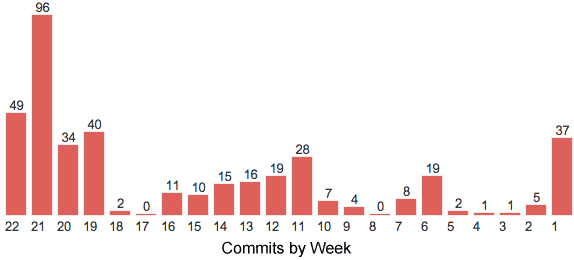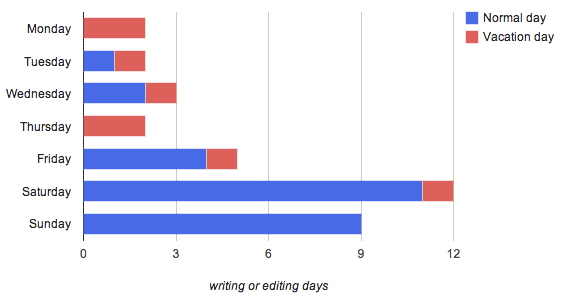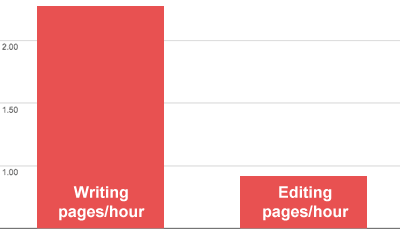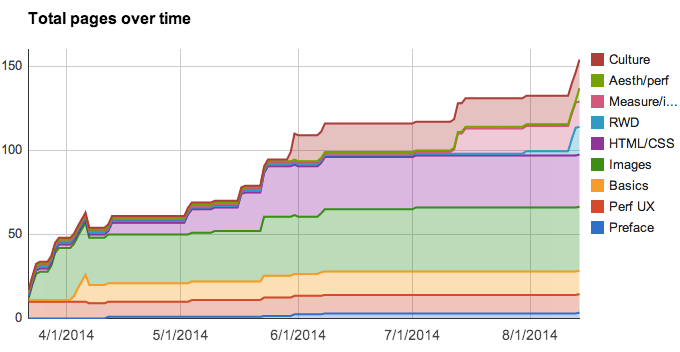Quantifying the book writing process: my first draft
The first draft of Designing for Performance is done! There is still a ton left to do: get feedback from reviewers, incorporate the feedback, then go through all of the publishing steps like proofreading, getting the figures redrawn, etc. But in this brief pause in the process as I wait for reviewers to take a look, I decided to analyze the first draft writing process, inspired by Ilya Grigorik’s retrospective on his own writing process.
I’m using two different datasets for this post:
- a Google Docs spreadsheet in which I manually entered daily hour + page data so I could track which days were primarily writing days and which were editing/reviewer feedback days
- the git log from O’Reilly’s book repo, using GitStats for analysis
The git log includes a few random commits from other folks (primarily O’Reilly admins reformatting the book so that the Early Release could be printed), but it’s clean enough to look at rough data.
Writing and editing patterns
There was a lot of common advice I heard from fellow authors:
- lean on the O’Reilly online reviewer tool, Atlas, to gather feedback
- utilize O’Reilly’s provided git repo for your book in combination with Atlas to track edits
- write every day (even if you don’t feel like it)
I totally ignored that last one. :) I wrote only when I felt like it, and this worked really well for me. I wrote when I had large chunks of time to focus and when I knew what I wanted to say. This meant that out of 146 days from start to finish (from the day I made my first commit to the day I completed the first draft), I only committed work during 35 of those days. I took many breaks from the book during busy times in my life:

I feel extremely fortunate to be able to take these breaks, and that writing came so easily (and was so much fun for me). I attribute it to having written and given presentations (and a keynote!) on this particular topic for years, and having a background in writing thanks to my Philosophy degree. Some chapters required many hours of research (like the responsive web design chapter); others I was able to outline and easily fill out, having already amassed the right supporting research during previous work.
Of those 35 days in which I worked on the book, 13 days were spent just making edits or incorporating reviewer feedback, and 24 days were actually spent researching and writing the original draft. The page count added/subtracted over time roughly matches to the commits by week pattern as well:

I also didn’t go overboard with number of hours writing or editing per day. I was intentional about taking breaks and having a life outside of book writing.
| Daily Stats | Hours Writing | Hours Editing |
|---|---|---|
| Mean | 2.4 | 1.3 |
| Median | 2.5 | 1 |
| Min | 0.5 | 0.5 |
| Max | 6.5 | 2 |
That 6.5 hour day writing was the first day in which I got everything set up with O’Reilly’s repo, created all the files and the outline, and effectively wrote the first chapter. The second-longest day, 5.25 hours, was when I wrote the bulk of the images chapter, which is the longest chapter by far. Here’s a histogram of hours per day spent writing:

Again, most of my writing was done on weekends. Occasionally I’d write in the evening of a weekday, and there were some weekdays that were holidays or vacation days when I wrote during the day. When we take a look at the hour of the day combined with day of the week, we can see that pattern:

I spent the last week of writing on vacation, intentionally taking a little getaway to complete the last two chapters. In this graph, I combined holidays and vacation days to see how they stacked up against a normal writing week.

Overall, I wrote at a pace of roughly 2 pages per hour, writing/editing for roughly 75 hours total. (This includes time spent researching, reading reviewer feedback, etc.) 80% of those hours were spent writing (20% editing) and there’s naturally a big difference in pages/hour velocity when you break it down by writing vs editing days:

Creating writing goals
As I was writing the draft, I had a pretty good idea of what I wanted to say. I’ve been presenting on this topic for years, have written about it a bunch in blog post or article form already, and knew what kind of research I’d have to do to fill it out. I set some goals for myself in terms of page count to make sure I’d reach for my total goal of 150 pages and conditionally formatted the page count as I worked toward each chapter’s goal.

(The preface pages obviously didn’t count toward the 150 page count.)
The chapters came in pretty close to their estimates! Having the page count goal helped me calculate how many hours were left based on my pages/hour velocity, too. I also was able to calculate “Pages to next donut”:
=(80%-'Pct done')*150
Where 80% was the threshold to meet for the next donut. These chapter page counts will all change, of course, once I get reviewers to take a look at the first draft. I didn’t write them in the order that they’re found in the book; I wrote when I had something to say, so I jumped around a bit. Here’s the total page count over time by chapter:

To say that I thoroughly enjoyed the book writing process is an understatement. Except for a few natural challenges, it’s been a ton of fun for me, very stress-free, and something I would absolutely want to do again (should I have something interesting to say). It’s so different than the other kinds of writing I’m used to (long papers in college, blog posts, articles, etc.) and has definitely rewired parts of my brain. I also really like the collaborative feeling that happens when reviewers send feedback, thoughts, and questions. I’ve also gotten to know many of my reviewers better through the process, which has been so cool. I’m really excited for the next parts of the publishing process: incorporating all the feedback I’ll be getting, working with O’Reilly on proofreading and redrawing the figures, and getting it printed.
You can still get the early release of the ebook which will contain all of the chapters as they get uploaded (still rough and unedited, of course)!